ECU 101 COURSE: MIKE DELANEY'S ECU BASICS YOU SHOULD KNOW
![Image]()
1. Should I get a "one size-fits all" or "off the shelf" Mugen, Jet, Spoon, Skunk2, Comptech, Neuspeed, FF Squad, Inline4, Power XS, Bayou Performance, or Dinan ECU which are "best guess" chips? How about getting one of those chips I see for sale on ebay all the time?
![Image]()
![Image]()
1A. First, Don't Chip Too Early
There is no point in getting a new ECU program early in your engine build up and then later upgrading to bigger lift and duration cams, or larger injectors, bigger fuel pump, or an aftermarket IM/bigger bore TB , etc. , since these parts just render your "new" ECU program obsolete and useless (ie. any power gains from the chip are eliminated).
So please do not get your chip reprogrammed just after i/h/c/e , if you later plan on going for bigger & better things in the future. It's supposed to be one of your last modifications and not one of your first, to prevent the need for multiple chip reprogrammings after each addition of a new modification.
The reason you see so many chips for resale on ebay?:
Other enthusiasts made the mistake of buying a chip too early that was not programmed correctly for the unique way their engine package breathes. It made very little power for them , or likely made their engine run too rich, or both. They are now trying to recover the money lost from an obsolete or incompatible chip.
Then there are the programmers who take advantage of import enthusiasts who do not understand the performance difference between a pre-programmed, mail-order chip versus a chip tuned and programmed on your car at a dyno. They are selling them based on the attractiveness of convenience for unsuspecting people who don't have a local programmer and dyno, the hyped hp gains from the magazine articles or ads, and a lower cost compared to other significant hp gain modifications, like cams or an intake manifold (IM).
![Image]()
1B. Second, What does an ECU do and what am I doing when I get a new chip ?
The ECU controls:
- the fuel map (ie. program commands for how much fuel to add at each rpm) and sequential firing of the injectors
- ignition map (program commands for how much spark timing to advance or retard from the baseline ignition timing you set at the distibutor cap at each rpm)
- VTEC switchover
- Redline
- Speed limiter (JDM and European models)
- Knock sensor warning
- Second O2 sensor CEL warning in OBD 2 and OBD 2b cars for testpipes and high flow cats and closed loop operations
- Activates the opening of the secondary runners' valves based on the IAB vacuum input, if you have a dual stage IM (eg. 3rd gen. GSR)
The ECU also activates your other CEL error codes and controls A/C & Idle/EVAP inputs/outputs.
When you get a new chip, the programmer has changed the program's commands of the ignition map and fuel map in response to a change in air flow and rpm (ie. both are indicators of "engine load"). The amount of ignition timing and fuel delivery is changed for a given air flow and rpm compared to the stock program. The programmer can also remove or inactivate the sensor CEL warning codes and move the VTEC point, redline, and speed limiter points to anywhere you like.
http://www.hondata.com/techecuanatomy.html
What do these ECU program's commands look like?
Example of a 3 dimensional ignition table of program commands (or "ignition map"):
Manifold Absolute Pressure or MAP which monitors air flow (Y axis), RPM (X-axis), and Ignition Advance/Retard from Baseline Timing (Z-axis).
![Image]()
There is also a 3-D fuel table (or "fuel map") which has Intake Manifold Pressure (Y-axis), RPM (X-axis), and Fuel Values instead of spark Advance (Z-axis).
The program commands can be entered on 2 dimenional tables.
Example of a 2-Dimensional fuel table's commands during a GSR's VTEC cam lobe operation . :
RPM down the Y axis to far left, MAP (mBar) across the top row, and fuel values for the injector duty cycle in the table cells.
![Image]()
http://www.technosquareinc.com/techtom.htm
http://www.techtom.co.jp/ROMpriceN.html
http://www.hondata.com/ecucomparison.html
http://www.200sx.org/ecudata.html
An "off the shelf" or mail order ECU is a programmer's best guess at trying to make a program that will fit as many different engine combination of mods as possible...that's why I call these "one-size-fits-all". These usually get you in the no gain or 5% disappointment gain ballpark. You will not get major gains with these "best guess" chips. Save your money.
So you want to make major power gains (ie. 13-15% or at least 7 whp from midrange up) with an ECU reprogram?
Please get a true custom chip instead, programmed on YOUR unique car with its own combination of mods, on a dyno using a wideband exhaust O2 sensor/Air:Fuel Ratio meter. This is the only way to go, if you are serious about getting the most out of a computer program upgrade for a street/race setup. If you got your chip by mail then, please understand that you did not get the most out of it...even the custom pre-programmed, mail-order kind of chips. The only correct way is to do the reprogramming on the dyno. And this leads us to who do you go to?
If you are lucky like me and have a couple of local programmers with Honda experience near your town, then your local programmer will go with you to the dyno and work his experience in tuning on the laptop and EPROM or EEPROM burner.
If you do not have a local programmer or race shop that does programming, then I strongly recommend getting together with some friends and investing in a Hondata Stage 4 or P200 system. It allows YOU to tune YOUR car on the dyno or at the track using elapsed times between known rpm points.
It comes with a chip burner, chips ($25/each), emulation laptop capability, instructions, and tech support. Investing in a wide band O2 sensor like the MOTEC they sell is also a good idea. This takes the guess and disappointment out of ECU upgrading.
If you want to go at this alone, then an AEM EMS is worth looking into, since it has base programs and laptop emulation. This is a serious investment for serious people.
If neither of these appeal to you and you insist on getting a mail order chip knowing that it won't be the best program, then stick to the known programmers (PM me if you want recommendations from people I've known who do a decent "best guess" chip). Most people who buy a mail order chip usually have a piggyback tuning box, like an Apex fuel controller (SAFC or VAFC) or Field SFC VTEC/fuel controller, and use those to further tune the fuel delivery on the dyno with a wideband O2 sensor.
http://www.hondata.com/techwidebandtuning.html
Chip reprogramming at the dyno requires a wideband universal exhaust gas oxygen sensors (called an UEGO that you can get from dyno shop or race shop) to measure air:fuel ratio at each rpm. Expect at least 3-4 hr dyno time minimum to tune these even if you are experienced at partial and wide open throttle fuel tuning.
Other systems to consider are the Motec M4, Apex Power FC, Accel DFI, SDS EF3, and Electromotive Tec3. Compare processor speed (16 bit, 16 MHz versus 32 bit, 33MHz ), available baseline programs to get you going without startin from scratch, sensor compatibility, emulators availability, and a good track record for tech support/customer service (not just whether they have one or not).
---------------------------
2. Why will an "off the shelf" mail order ECU Disappoint?
What about standalone computers like a Hondata instead of a redone chip ?
3. Some Basic ECU Info for OEM Honda ECUs
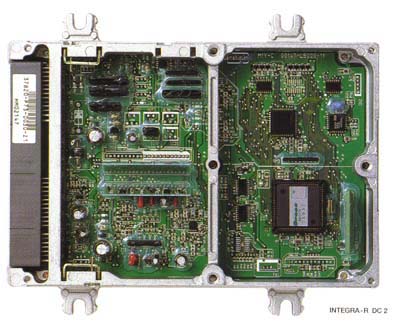
1. Should I get a "one size-fits all" or "off the shelf" Mugen, Jet, Spoon, Skunk2, Comptech, Neuspeed, FF Squad, Inline4, Power XS, Bayou Performance, or Dinan ECU which are "best guess" chips? How about getting one of those chips I see for sale on ebay all the time?
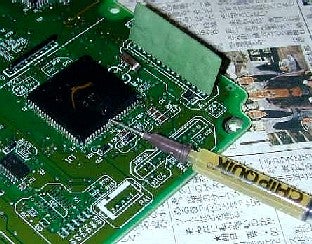
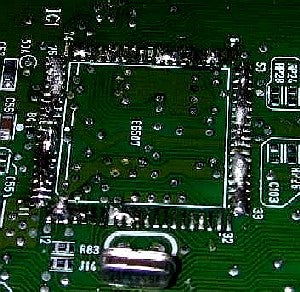
1A. First, Don't Chip Too Early
There is no point in getting a new ECU program early in your engine build up and then later upgrading to bigger lift and duration cams, or larger injectors, bigger fuel pump, or an aftermarket IM/bigger bore TB , etc. , since these parts just render your "new" ECU program obsolete and useless (ie. any power gains from the chip are eliminated).
So please do not get your chip reprogrammed just after i/h/c/e , if you later plan on going for bigger & better things in the future. It's supposed to be one of your last modifications and not one of your first, to prevent the need for multiple chip reprogrammings after each addition of a new modification.
The reason you see so many chips for resale on ebay?:
Other enthusiasts made the mistake of buying a chip too early that was not programmed correctly for the unique way their engine package breathes. It made very little power for them , or likely made their engine run too rich, or both. They are now trying to recover the money lost from an obsolete or incompatible chip.
Then there are the programmers who take advantage of import enthusiasts who do not understand the performance difference between a pre-programmed, mail-order chip versus a chip tuned and programmed on your car at a dyno. They are selling them based on the attractiveness of convenience for unsuspecting people who don't have a local programmer and dyno, the hyped hp gains from the magazine articles or ads, and a lower cost compared to other significant hp gain modifications, like cams or an intake manifold (IM).
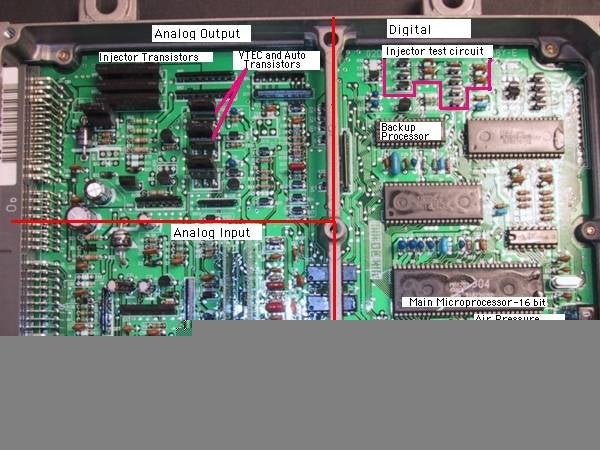
1B. Second, What does an ECU do and what am I doing when I get a new chip ?
The ECU controls:
- the fuel map (ie. program commands for how much fuel to add at each rpm) and sequential firing of the injectors
- ignition map (program commands for how much spark timing to advance or retard from the baseline ignition timing you set at the distibutor cap at each rpm)
- VTEC switchover
- Redline
- Speed limiter (JDM and European models)
- Knock sensor warning
- Second O2 sensor CEL warning in OBD 2 and OBD 2b cars for testpipes and high flow cats and closed loop operations
- Activates the opening of the secondary runners' valves based on the IAB vacuum input, if you have a dual stage IM (eg. 3rd gen. GSR)
The ECU also activates your other CEL error codes and controls A/C & Idle/EVAP inputs/outputs.
When you get a new chip, the programmer has changed the program's commands of the ignition map and fuel map in response to a change in air flow and rpm (ie. both are indicators of "engine load"). The amount of ignition timing and fuel delivery is changed for a given air flow and rpm compared to the stock program. The programmer can also remove or inactivate the sensor CEL warning codes and move the VTEC point, redline, and speed limiter points to anywhere you like.
http://www.hondata.com/techecuanatomy.html
What do these ECU program's commands look like?
Example of a 3 dimensional ignition table of program commands (or "ignition map"):
Manifold Absolute Pressure or MAP which monitors air flow (Y axis), RPM (X-axis), and Ignition Advance/Retard from Baseline Timing (Z-axis).
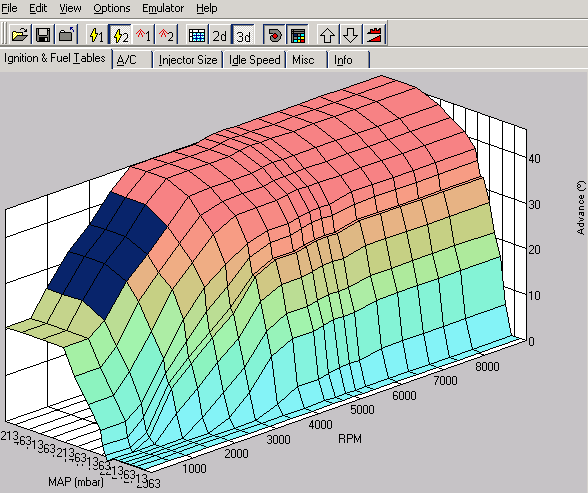
There is also a 3-D fuel table (or "fuel map") which has Intake Manifold Pressure (Y-axis), RPM (X-axis), and Fuel Values instead of spark Advance (Z-axis).
The program commands can be entered on 2 dimenional tables.
Example of a 2-Dimensional fuel table's commands during a GSR's VTEC cam lobe operation . :
RPM down the Y axis to far left, MAP (mBar) across the top row, and fuel values for the injector duty cycle in the table cells.
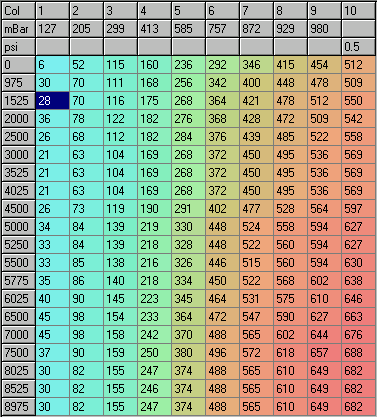
1C. Third, "Best Guess" programs are not as good.
http://www.technosquareinc.com/techtom.htm
http://www.techtom.co.jp/ROMpriceN.html
http://www.hondata.com/ecucomparison.html
http://www.200sx.org/ecudata.html
An "off the shelf" or mail order ECU is a programmer's best guess at trying to make a program that will fit as many different engine combination of mods as possible...that's why I call these "one-size-fits-all". These usually get you in the no gain or 5% disappointment gain ballpark. You will not get major gains with these "best guess" chips. Save your money.
So you want to make major power gains (ie. 13-15% or at least 7 whp from midrange up) with an ECU reprogram?
Please get a true custom chip instead, programmed on YOUR unique car with its own combination of mods, on a dyno using a wideband exhaust O2 sensor/Air:Fuel Ratio meter. This is the only way to go, if you are serious about getting the most out of a computer program upgrade for a street/race setup. If you got your chip by mail then, please understand that you did not get the most out of it...even the custom pre-programmed, mail-order kind of chips. The only correct way is to do the reprogramming on the dyno. And this leads us to who do you go to?
If you are lucky like me and have a couple of local programmers with Honda experience near your town, then your local programmer will go with you to the dyno and work his experience in tuning on the laptop and EPROM or EEPROM burner.
If you do not have a local programmer or race shop that does programming, then I strongly recommend getting together with some friends and investing in a Hondata Stage 4 or P200 system. It allows YOU to tune YOUR car on the dyno or at the track using elapsed times between known rpm points.
It comes with a chip burner, chips ($25/each), emulation laptop capability, instructions, and tech support. Investing in a wide band O2 sensor like the MOTEC they sell is also a good idea. This takes the guess and disappointment out of ECU upgrading.
If you want to go at this alone, then an AEM EMS is worth looking into, since it has base programs and laptop emulation. This is a serious investment for serious people.
If neither of these appeal to you and you insist on getting a mail order chip knowing that it won't be the best program, then stick to the known programmers (PM me if you want recommendations from people I've known who do a decent "best guess" chip). Most people who buy a mail order chip usually have a piggyback tuning box, like an Apex fuel controller (SAFC or VAFC) or Field SFC VTEC/fuel controller, and use those to further tune the fuel delivery on the dyno with a wideband O2 sensor.
http://www.hondata.com/techwidebandtuning.html
Chip reprogramming at the dyno requires a wideband universal exhaust gas oxygen sensors (called an UEGO that you can get from dyno shop or race shop) to measure air:fuel ratio at each rpm. Expect at least 3-4 hr dyno time minimum to tune these even if you are experienced at partial and wide open throttle fuel tuning.
Other systems to consider are the Motec M4, Apex Power FC, Accel DFI, SDS EF3, and Electromotive Tec3. Compare processor speed (16 bit, 16 MHz versus 32 bit, 33MHz ), available baseline programs to get you going without startin from scratch, sensor compatibility, emulators availability, and a good track record for tech support/customer service (not just whether they have one or not).
---------------------------
2. Why will an "off the shelf" mail order ECU Disappoint?
SDS and Hondata agrees with me that the best way to rechip your computer is to program your ECU instead on the dyno on your car rather than buying a previously programmed "best guess" chip made to fit as many different engine packages as possible.
Here is some very good advice when buying a pre-programmed , "mail order" performance chip from SDS' website that I have found to be true:
Be careful. Some unscrupulous programmers will promise to sell you a "Mugen" like chip but in reality, all they have done is moved the redline higher and removed the CEL warnings. The advice to stick to known reputable programmers is wise, if you plan on mail orders.
What about standalone computers like a Hondata instead of a redone chip ?
-------------------------------
3. Some Basic ECU Info for OEM Honda ECUs




